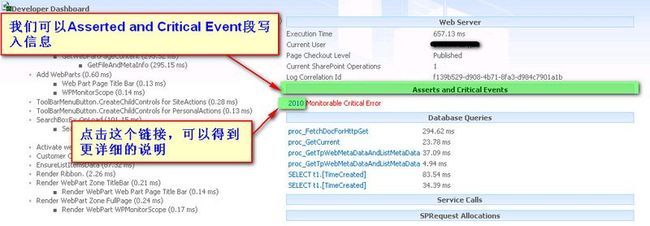Sharepoint学习笔记—Debug&TroubleShooting--Developer Dashboard的使用(3.向Assert and Critical Events段插入信息)
如果你开发了一个Webpart并把它呈现到Sharepoint网站上时,Sharepoint会创建一个top-level的scope,在这个Scope中,Sharepoint加入了一个名叫SPCriticalTraceCounter的Monitor,这个Monitor可以被用来向Developer Dashborad的Assert and Critical Events段插入信息。如下图:

如果你点击信息条左边的链接,你就可以得到更多关于这个记录事件的信息内容(当前事件的调用堆栈)。如下图:

如何向Developer Dashboard的这个Assert and Critical Events信息段中插入信息呢?我们可以使用SPCriticalCounter类的一个静态函数AddDataToScope来实现。
当有相应的请求传来时,通常Sharepoint会自动加载这个SPCriticalCounter的Monitor,当然还有其它一些Monitor也会和它一起加载,SPCriticalCounter类定义如下
SPCriticalCounter是一个封闭类,它继承了ISPScopedPerformMonitor接口,这个接口我们在上一篇有介绍。
我们可以使用如下代码来添加用户的相关信息:
SPCriticalTraceCounter.AddDataToScope(
2010,
" Critical Error ",
15,
" An Critical error occurred ");
}
AddDataToScope静态函数的定义如下
上面的定义代码中
第一个参数是一个用户定义的标签值(custom tag id)用于标识记录项
第二个参数是一个string类型,它是这个记录项的分类(category)
第三个参数是一个int类型,它标识跟踪层次(trace level),通过Reflector分析我们可以看到,它对应于Microsoft.SharePoint.Diagnostics.ULSTraceLevel的枚举定义,相关值如下:
{
High = 20,
Medium = 50,
Monitorable = 15,
Unexpected = 10,
Verbose = 100,
VerboseEx = 200
}
第四个参数是这个记录项真正的记录信息。